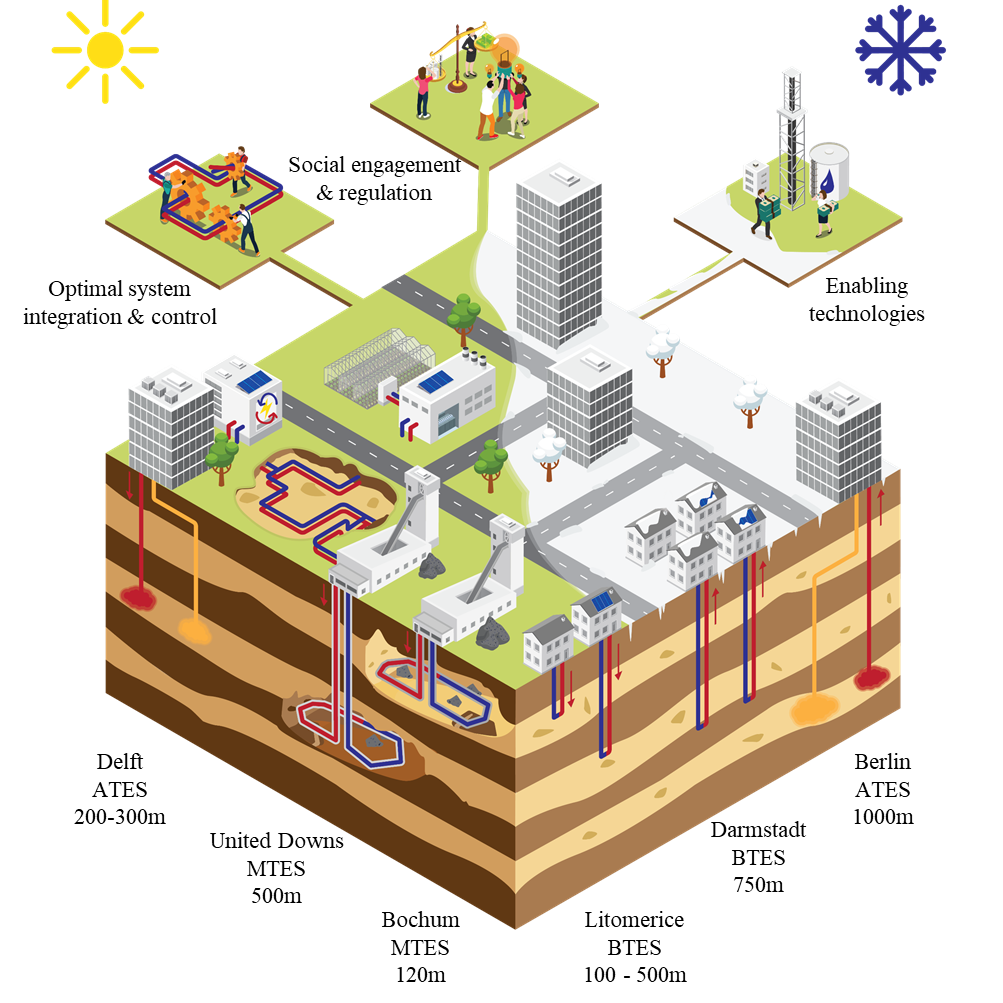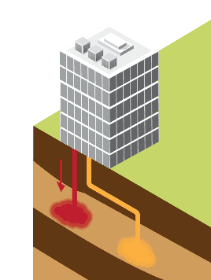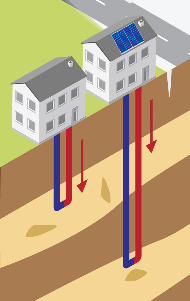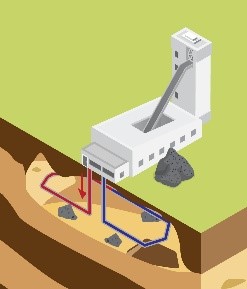20 million EU Grant for research underground heat storage
The EU aims to have a net-zero greenhouse gas (GHG) economy by 2050. At present, heating and cooling represent around 50% of the final energy demand in Europe and are for a large part supplied by fossil fuel derived energy. Large scale seasonal heat storage is a key strategy to decarbonize heating in order to achieve EU ambitions, because sustainable sources like geothermal and solar provide a lot of heat in summer, while we need it in winter. The PUSH-IT consortium receives this Horizon Europe grant to demonstrate and develop such heat storage systems. PUSH-IT stands for Piloting Underground Seasonal Heat Storage In geothermal reservoirs.
TU Delft is leader of PUSH-IT. Martin Bloemendal is an assistant professor at the department of Water Management at the faculty of Civil Engineering and Geosciences and at KWR, and will lead the project. ‘PUSH-IT will be a showcase with a full-scale application of seasonal heat storage (up to 90°C) in geothermal reservoirs using three different technologies known as Aquifer, Borehole and Mine Thermal Energy Storage (ATES, BTES, MTES)*. At 6 different sites in Europe they together represent relevant geological conditions, which are widely available across Europe.’ *See explanation in section
Learning while doing
PUSH-IT will pilot and develop each of the technologies: ATES in Delft, BTES in Darmstadt and MTES in Bochum, while we also have follower sites for each technology: Berlin, Litomerice (Czech Republic) and Cornwall respectively. ‘Among many other things, we will reduce environmental impact and improve performance by simulating and monitoring heat losses in the underground and optimize design and operations accordingly to limit such losses. Furthermore, we will optimize integration of the storage via demand-side management with machine learning control technologies. Also citizen engagement, analysing motivations and perceptions of heat storage, and investigating governance policies and business models that engage citizens in decision making regarding urban heating systems including storage are non-technical, but very important elements in the project’, says Bloemendal.
There will be 3 demo sites for novel technology demonstration in Delft, Darmstadt and Bochum . And 3 follower sites in Berlin, Litomerice (Czech Republic) and United Downs (Cornwall), one for each heat storage technologies. System integration, technology development and societal engagement are important to contribute to the activities at the different sites which will enable PUSH-IT to realise its results.
Unique combination of ATES and Geothermal in Delft
The source of heat for the ATES in Delft will be the planned geothermal well on TU Delft Campus. ‘When this has been realised and is running, the geothermal well will also produce heat in summer, while the demand is low. The heat produced in summer will be stored in the ATES system, in the local aquifer at around 200m depth, and extracted again in winter. ‘With the heat from the ATES, also peak demand can be supplied from sustainable resources instead of burning gas’, explains Bloemendal. ‘This will further reduce the GHG emissions for heating the campus and could also be used for the city of Delft.’ The combination of ATES and geothermal in the built environment is unique in the world and makes the TU Delft stand out internationally. Not only because of the application of this combination, but also the associated research and education that will be carried out at these facilities. Key innovations developed by PUSH-IT at the Delft site relate to drilling, completion and well design as well as monitoring and testing of the geothermal well, water quality control and system integration/control.
A wide scope on seasonal heat storage innovations
‘In PUSH-IT we will develop, deploy and test our technologies for a variety of configurations of heat sources, heat storage technologies, geological conditions, distribution systems, stakeholder populations and market and legal conditions. Hence, the programme provides a unique scope on demonstration, integration and advances for seasonal heat storage in the summer to be used in the winter. PUSH-IT will realise monitored and assessed operational projects and use these to generate generic solutions and practices relevant across Europe. These results will enhance the utilisation of sustainable energy and create a balanced system for sharing benefits and burdens tied to sustainable heat generation, storage and distribution activities,’ says Bloemendal. In order to successfully achieve this, the PUSH-IT consortium combines heat suppliers, well drillers, public planning offices and academic partners.
Bloemendal reflects: ‘The energy transition is now. It is a privilege to work on this EU topic with an international consortium to demonstrate the use of high temperature geothermal reservoirs to provide energy storage for the sustainable energy system. For now and our near future’.
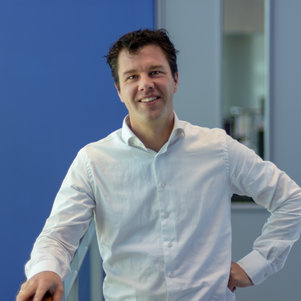
Martin Bloemendal
The Consortium
The PUSH-IT consortium has 19 partners combined as heat suppliers, well drillers, public planning offices and academic partners. The transdisciplinary collaboration will start at January 2023. Delft University of Technology is coordinator of PUSH-IT. The programme received an Horizon EU grant of 20 M euro’s (Innovation Action score 15/15).
National partners
EQUANS, KWR Water Research Institute, Universiteit Utrecht en Huisman Geo b.v. en Grondboorbedrijf Haitjema b.v.
International partners
Technische Universität Darmstadt, University of Exeter, Fraunhofer- IEG, Ruhr-Universitaet Bochum Helmholtz Zentrum Potsdam GFZ, Vlaamse Instelling voor Technologisch Onderzoek, Ceska Geologicka Sluzba, Bureau De Recherches Géologiques Et Minières (BRGM), British Geological Survey (BGS) , Anglia Ruskin University, Université de Genève, Univerzita Karlova, Geothermal Engineering Ltd.
Explanation about ATES, BTES en MTES
Aquifer thermal energy storage (ATES) is the storage and recovery of thermal energy in aquifers, which are permeable layers that contain groundwater. ATES systems use 2 or more groundwater wells for the simultaneous injection or extraction of groundwater to carry heat to or from the aquifer. Storage and recovery of heat is achieved by subsequent injection of hot groundwater in the so-called hot well in summer and extraction from the warm or cold well in winter. Hence, the groundwater is used as a carrier for the heat. Systems commonly operate at low temperature level in combination with a heat pump, more than 3,000 of such systems operational world-wide. Heat storage at higher temperature levels (HT) in ATES has large potential, but requires development of the technology before large scale adoption is possible, less than 10 HT-ATES systems. Heating and cooling when you need it! Low temperature ATES at TU Delft campus explained.
Borehole Thermal energy storage (BTES) is a large, underground heat exchanger. A BTES system consists of a set of tubes installed in the underground, placed vertically in in a borehole. In the tubes a medium circulates, that allows for heat exchange with the surrounding sediment/rocks. In summer warm water circulates in the tubes, causing the underground around the borehole to heat-up. In winter cold water is circulated to extract the heat. Heat exchange with the underground occurs via conduction. Hence, BTES systems generally have lower capacity then ATES systems. Like ATES, also BTES is commonly applied at low temperature levels in combination with a heat pump, more than 1,000,000 systems operational world-wide, but requires development to be used for higher storage temperature.
Mine Thermal Energy Storage (MTES) utilise the groundwater present in abandoned mines. Like ATES, the groundwater present is used as a carrier for transporting the heat to and from the mine. So like ATES, hot groundwater is injected into the mine during summer, and extracted in winter.
MTES is a technology under development, currently less than 5 systems are operational world-wide.
